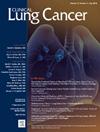Sacituzumab Govitecan-Hziy治疗晚期胸腺瘤或胸腺癌的II期平行对照研究
IF 3.3
3区 医学
Q2 ONCOLOGY
引用次数: 0
摘要
背景:胸腺上皮肿瘤(TETs),包括胸腺瘤和胸腺癌,是胸前纵隔的罕见肿瘤。对于晚期患者,以铂类药物为基础的化疗被用作一线治疗。然而,对于初始治疗后病情进展的TET,尚无标准治疗方案,晚期/复发TET的治疗选择也有限。Trop-2是一种跨膜糖蛋白,在包括胸腺瘤和胸腺癌在内的实体肿瘤中过表达。Sacituzumab govitecan-hziy是一种trop -2导向的抗体-药物偶联物,在包括乳腺癌在内的几种肿瘤中显示出疗效和安全性。Trop-2在tet中的过表达及其在其他恶性肿瘤中的临床疗效为探索其在胸腺瘤和胸腺癌中的应用提供了依据。方法:这项开放标签、单臂、平行队列、多中心研究评估了sacituzumab govitecan-hziy在既往接受过至少1条全身治疗(NCT06248515)的晚期胸腺瘤(队列A)和胸腺癌(队列B)患者中的安全性和有效性。该研究采用Simon最优两阶段设计,入组表现良好、疾病可测量、器官功能良好的患者。Sacituzumab govitecan-hziy在21天周期的第1天和第8天以固定剂量10mg /kg每周给药,直到疾病进展或不可接受的毒性。停药后每6个月随访2年。档案组织在研究治疗开始前获得,在进展时可选择活检。在没有档案组织的情况下,在基线处进行新鲜活检。主要终点是使用实体肿瘤反应评价标准v1.1 (RECIST)标准由研究者评估的缓解率,在前3个月每2个周期进行肿瘤成像评估,之后每3个周期进行一次评估。次要终点包括不良事件(不良事件通用术语标准v5.0)、中位和6个月无进展生存期、反应持续时间和总生存期。每个队列将入组9名患者。如果9名患者中0名达到应答,则不再纳入该队列。如果前9名患者中有1名或更多患者有反应,则将继续累积,直到该队列中共有17名患者入组。本文章由计算机程序翻译,如有差异,请以英文原文为准。
Phase II Parallel Arm Study of Sacituzumab Govitecan-Hziy in Patients With Advanced Thymoma or Thymic Carcinoma
Background
Thymic epithelial tumors (TETs), including thymoma and thymic carcinoma, are rare thoracic tumors of the anterior mediastinum. For those with advanced disease, platinum-based chemotherapy is used as first-line treatment. However, there is no standard regimen established for TET at progression after initial therapy, and treatment options for advanced/recurrent TETs are limited. Trop-2, a transmembrane glycoprotein, is overexpressed in solid tumors including thymomas and thymic carcinomas. Sacituzumab govitecan-hziy, a Trop-2-directed antibody-drug conjugate, has shown efficacy and safety in several tumors including breast cancer. The overexpression of Trop-2 in TETs and the clinical efficacy in other malignancies provide rationale for exploring its use in thymoma and thymic carcinoma.
Methods
This open-label, single-arm, parallel cohort, multi-center study assesses the safety and efficacy of sacituzumab govitecan-hziy in patients with advanced thymoma (cohort A) and thymic carcinoma (cohort B) who have received at least 1 prior line of systemic therapy (NCT06248515). The study employs a Simon optimal 2-stage design, enrolling patients with adequate performance status, measurable disease, and adequate organ function. Sacituzumab govitecan-hziy is administered at a fixed dose of 10 mg/kg weekly on days 1 and 8 of 21-day cycles until disease progression or unacceptable toxicity. Follow-up continues every 6 months for 2 years postdiscontinuation. Archival tissue is obtained prior to initiation of study treatment with an optional biopsy at the time of progression. In cases where archival tissue is not available, a fresh biopsy is obtained at baseline. The primary endpoint is investigator-assessed response rate using Response Evaluation Criteria in Solid Tumors v1.1 (RECIST) criteria, with tumor imaging assessments every 2 cycles during the first 3 months and every 3 cycles thereafter. Secondary endpoints comprise adverse events by Common Terminology Criteria for Adverse Events v5.0, median and 6-month progression-free survival, duration of response, and overall survival. For each cohort, 9 patients will be enrolled. If 0 of the 9 achieve a response, no further patients will be enrolled in that cohort. If 1 or more of the first 9 patients has a response, accrual will continue until a total of 17 patients have been enrolled in that cohort.
求助全文
通过发布文献求助,成功后即可免费获取论文全文。
去求助
来源期刊

Clinical lung cancer
医学-肿瘤学
CiteScore
7.00
自引率
2.80%
发文量
159
审稿时长
24 days
期刊介绍:
Clinical Lung Cancer is a peer-reviewed bimonthly journal that publishes original articles describing various aspects of clinical and translational research of lung cancer. Clinical Lung Cancer is devoted to articles on detection, diagnosis, prevention, and treatment of lung cancer. The main emphasis is on recent scientific developments in all areas related to lung cancer. Specific areas of interest include clinical research and mechanistic approaches; drug sensitivity and resistance; gene and antisense therapy; pathology, markers, and prognostic indicators; chemoprevention strategies; multimodality therapy; and integration of various approaches.
 求助内容:
求助内容: 应助结果提醒方式:
应助结果提醒方式:


